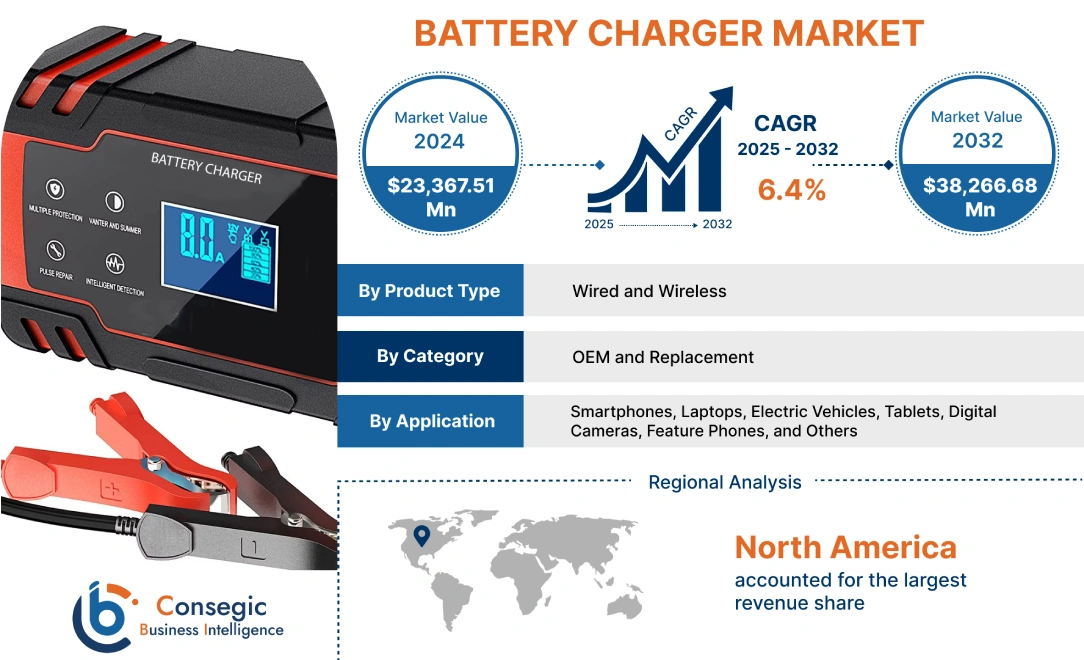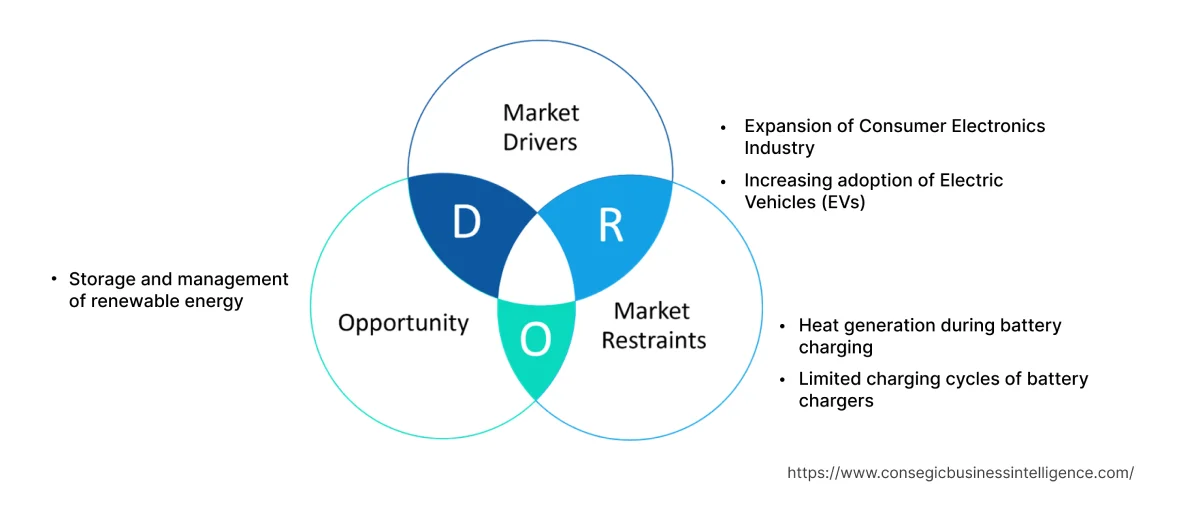- Summary
- Table Of Content
- Methodology
Battery Charger Market Size :
Battery Charger Market size is estimated to reach over USD 38,266.68 Million by 2032 from a value of USD 23,367.51 Million in 2024 and is projected to grow by USD 24,437.32 Million in 2025, growing at a CAGR of 6.40% from 2025 to 2032.
Battery Charger Market Scope & Overview:
A battery charger is an equipment used to provide energy to the battery by passing an electric current through it. Battery charger consists of components including power circuit, regulator circuit, rectifier circuit, control circuit, and fault detection circuit. A battery functions by converting the chemical energy stored within the battery into electrical power. Moreover, the battery needs to be recharged once the chemical energy stored in the battery is exhausted during its conversion into electrical energy. Therefore, a battery charger is utilized to provide Direct Current (DC) to the battery to reload the used-up electrolyte.
Battery Charger Market Insights :
Key Drivers :
Expansion of Consumer Electronics Industry Fuels the Market Progress
The increasing adoption of consumer electronics devices among households is driving the growth of the battery charger market. The proliferation of portable consumer electronic devices such as smartphones, laptops, and tablets has significantly increased the demand for battery chargers that enable continuous operation of electronic devices by replenishing the energy stored in the batteries. Moreover, battery chargers provide extended battery life and fast charging capabilities to allow consumers electronics devices to function efficiently for prolonged periods. For instance, in October 2022, CTEK Sweden AB launched a new battery charger called CS ONE and maintainer with APTOTM (Adaptive Charging) technology for efficient and safe charging of lead-acid or lithium batteries. Thus, the growing adoption of portable electronics devices among consumers is accelerating the growth of battery charger market.
Increasing adoption of Electric Vehicles (EVs) Boosts the Market Development
The increasing adoption of electric vehicles due to the improved vehicle range and battery capacity is accelerating the growth of battery charger market. Electric vehicles use high-capacity lithium-ion batteries to provide improved energy density, discharge tolerance, cycle life, and faster re-charge times. Therefore, the primary function of battery chargers is to convert AC power from the electrical grid to DC power that is stored in the vehicle's battery pack. For instance, in November 2021, FreeWire Technologies launched Boost Charger 150 electric vehicle (EV) charger that improves charging speeds by 25%. Consequently, electric vehicle battery chargers are linked to the battery of EVs that extract power from the grid to charge the battery. Thus, the key features of the battery chargers to convert AC power into DC to power electric vehicles and its functioning is contributing to the battery charger market growth.
Key Restraints :
Heat generation during battery charging Restrains the Market Growth
Batteries generate heat during charging and discharging processes due to enthalpy changes, electrochemical polarization and resistive heating inside a battery. The battery generates heat through the oxidation and reduction of ions during the charging and discharging process, thereby increasing the battery temperature of the battery. As a result, the generation of extreme heat leads to battery corrosion that shortens the life of the battery. Therefore, the reduced performance of the batteries due to heat generation is hindering the growth of the battery charger market.
Limited charging cycles of battery chargers Hampers the Market Demand
The number of charge cycles that a battery provides is limited based on the type of battery and its usage. Consumer electronics devices such as laptops, tablets, and others comprise of lithium-ion batteries that possess 300 to 500 charging cycles. As a result, the battery starts to degrade and the capacity to hold a charge gradually decreases. Therefore, continuous charging has an effect on the overall lifespan of the battery. Consequently, the limited charging cycles of battery chargers is hindering the growth of the battery charger market.
Future Opportunities :
Storage and management of renewable energy Opens New Doors
The application of battery chargers for the storage of renewable energy is expected to present potential opportunities for the growth of the battery charger market during the forecast period. Battery chargers are expected to optimize the utilization of renewable energy, storage of excess energy for future applications, and enhance grid stability. Moreover, the growing awareness regarding renewable energy systems coupled with battery storage has increased the deployment of battery-based backup power systems. Consequently, battery chargers play a crucial role in storage and management of renewable energy, leading to market growth during the forecast period.
Battery Charger Market Report Insights :
| Report Attributes | Report Details |
| Study Timeline | 2019-2032 |
| Market Size in 2032 | USD 38,266.68 Million |
| CAGR (2025-2032) | 6.4% |
| By Product Type | Wired and Wireless |
| By Category | OEM and Replacement |
| By Application | Smartphones, Laptops, Electric Vehicles, Tablets, Digital Cameras, Feature Phones, and Others |
| By Region | North America, Europe, Asia-Pacific, Latin America, and Middle East & Africa |
| Key Players | Accutronics Limited, Analytic Systems Ware Ltd., Anoma Corporation, Associated Equipment Corporation, Energizer Holdings Inc., Exide Technologies, Ferro Magnetics Corporation, FRIWO AG, and HindlePower, Inc. |
Battery Charger Market Segmental Analysis :
By Product Type :
Based on the product type, the market is bifurcated into wired and wireless. The wired segment accounted for the largest revenue share in the year 2024. The ability of wired chargers to provide efficiency and high charging speed is driving the growth of the market. Wired charging takes less time to replenish the battery of devices such as smartphones, laptops, and tablets. Wired charging delivers a high current flow directly to the battery, allowing for a more efficient charging process. Moreover, wired chargers provide a reliable and smooth connection between a charger and a battery to ensure consistent flow of electricity.
The wireless segment is expected to witness the fastest CAGR growth during the forecast period. Wireless charging involves transferring power from the charger to a receiver in the device via electromagnetic induction. Wireless charging technology allows multiple devices to charge simultaneously, thereby eliminating the need for separate cables or wires. Moreover, wireless chargers automatically turn off once devices are fully charged to stop overheating leading to less damage to the battery. For instance, in July 2020, Qualcomm Technologies, Inc. launched Quick Charge 5, the fastest wireless commercial charging technology for Android devices to deliver high charging speed and efficiency for smartphones. Consequently, the ability of wireless chargers to transfer power to your phone efficiently is accelerating the growth of the market.
By Category:
Based on the category, the market is separated into OEM and replacement. The OEM (Original Equipment Manufacturer) segment accounted for the largest revenue share in the year 2024. OEM chargers are integrated with the original design and manufacturing of the device or system. Therefore, OEM battery chargers are compatible and provide seamless integration with the device to provide an efficient charging solution. For instance, in February 2022, 150W SUPERVOOC with Battery Health Engine (BHE) and 240W SUPERVOOC flash charge technology offering 1,600 charge cycles for fast charging and ensuring battery's health protection.
The replacement segment is anticipated to register the fastest CAGR growth during the forecast period. Replacement chargers are designed to be compatible for a wide range of devices or systems, allowing for flexibility in upgrading the charging capabilities of existing equipment. Moreover, replacement chargers provide a cost-effective solution for charging as the chargers provided by the OEM is quite expensive. Thus, the compatibility and cost-effectiveness of replacement chargers is expected to drive the market growth during the forecast period.
By Application :
Based on the application, the market is segregated into smartphones, laptops, electric vehicles, tablets, digital cameras, feature phones, and others. The smartphone segment accounted for the largest revenue share of 26.32% in the year 2024. A mobile charger works by converting AC power from a USB port or wall socket into DC power that is utilized to charge a mobile device's battery. Therefore, battery chargers play a crucial role in providing necessary power for efficient functioning of smartphones. Moreover, battery chargers are crucial in maintaining battery health and longevity in order to prevent damage to the smartphone batteries, resulting in market growth.
The electric vehicles segment is expected to emerge as the fastest-growing segment during the forecast period. Battery chargers play a crucial role in charging Lithium-ion batteries deployed in electric vehicles. Battery chargers in electric vehicles provide different charging modes and speeds to accommodate different charging requirements. Therefore, the increasing adoption of battery chargers in EV charging stations to convert AC power to DC power is accelerating the growth of the market. For instance, in September 2021, ABB launched an innovative all-in-one Electric Vehicle (EV) charger ideal for refueling stations, urban charging stations, retail parking and fleet applications. Thus, the ability of battery chargers to allow electric vehicles to function for prolonged periods is proliferating the growth of the market.
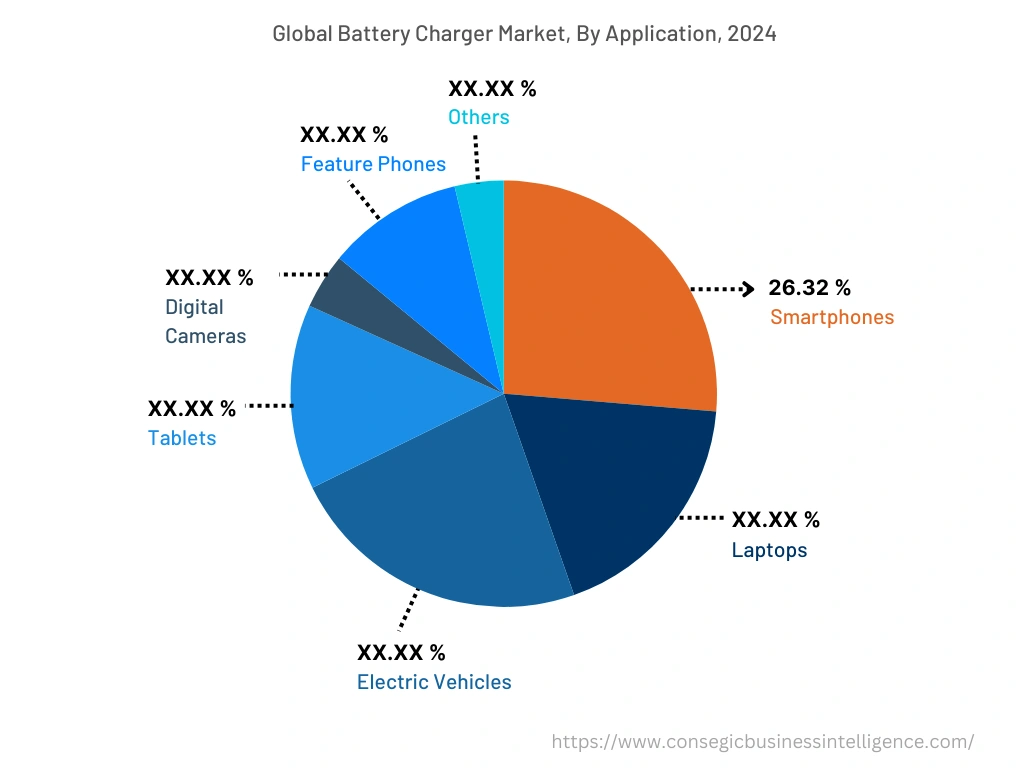
By Region :
The regional segment includes North America, Europe, Asia Pacific, Middle East and Africa, and Latin America.
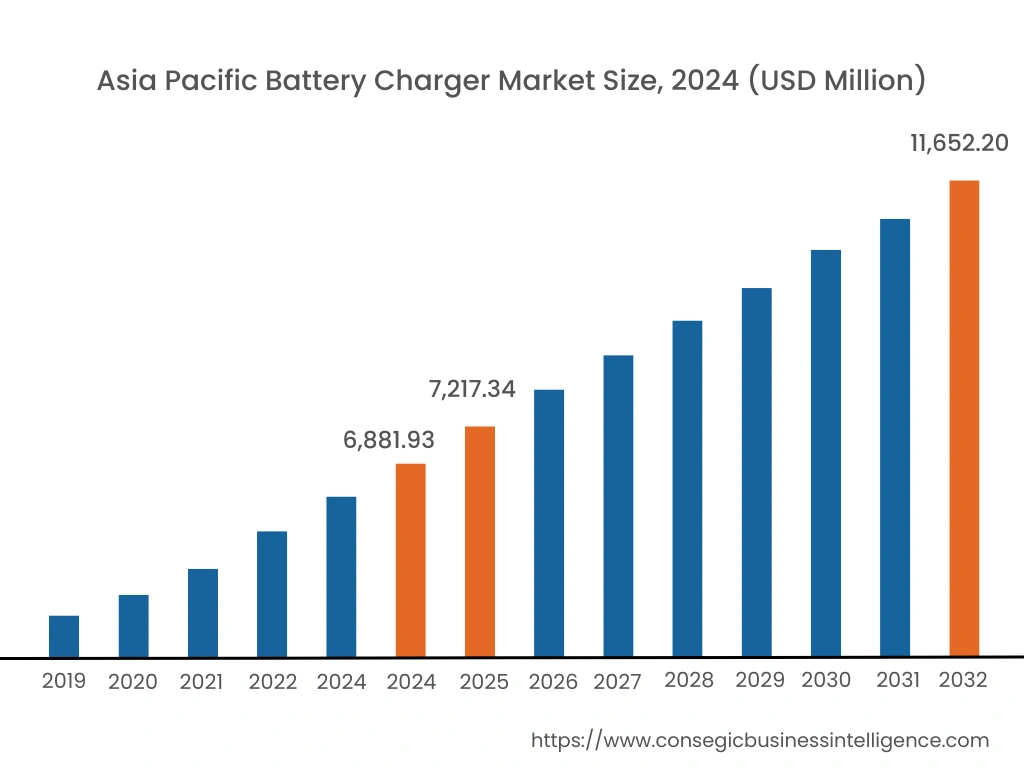
North America accounted for the largest revenue share in the year 2024. The increasing adoption of electric vehicles in the region is driving the growth of battery charger market. Battery chargers play a crucial role in charging the Lithium-ion batteries used for operating electric vehicles efficiently. For instance, according to IEA, sales of electric cars doubled to 6.6 million, representing approximately 9% of the global car market in 2021. Therefore, the rising adoption of electric vehicles among consumers is accelerating the growth of the regional market.
Asia Pacific region was valued at USD 6,881.93 Million in 2024. Moreover, it is projected to grow by USD 7,217.34 Million in 2025 and reach over USD 11,652.20 Million by 2032, registering a CAGR of 6.7% during the forecast period, 2025-32. In addition, in the region, China accounted for a revenue share of 29.5% in the same year. The growing adoption of consumer electronics devices such as smartphones, laptops, and tablets among the population is driving the growth of the market. Manufacturers are taking several initiatives to manufacture wired and wireless charging systems for efficient functioning of consumer electronics devices. Moreover, the growing trend of smart wearables among consumers is driving the demand for battery chargers, leading to the market growth during the forecast period.
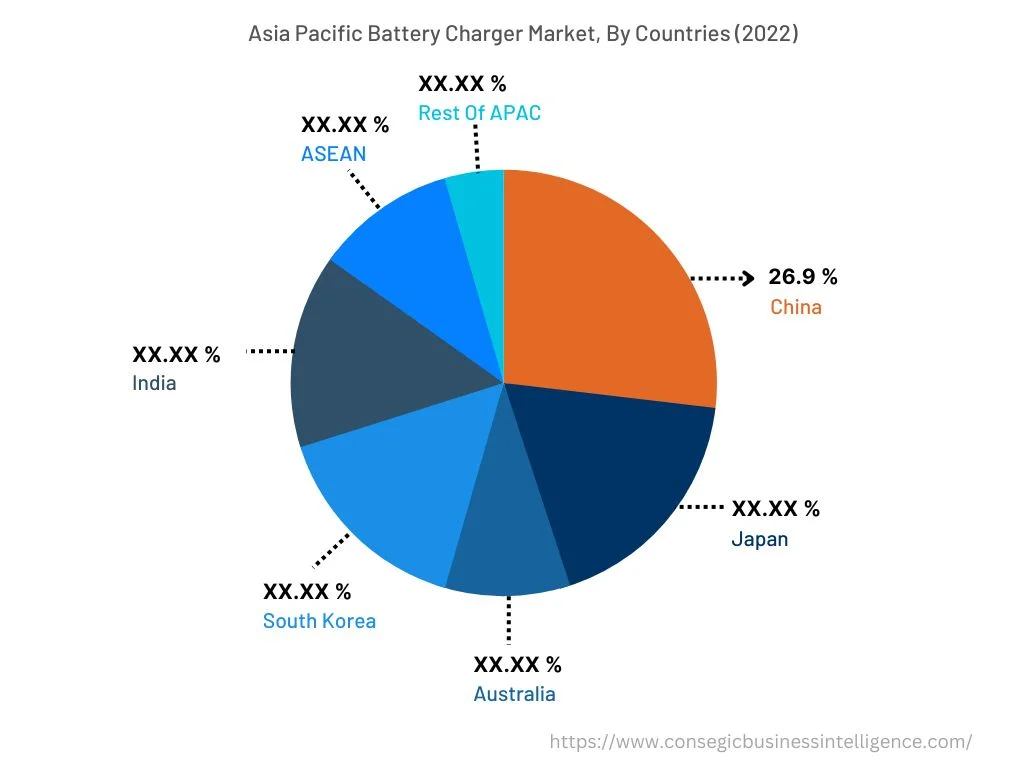
Top Key Players & Market Share Insights:
The battery charger market is highly competitive with major players providing battery chargers for smartphones, laptops, and electric vehicles. Key players are adopting several strategies in product innovation, research, and development (R&D), and various business strategies, and application launches have accelerated the growth of the battery charger market. Key players in the battery charger market include -
- Accutronics Limited
- Analytic Systems Ware Ltd.
- Associated Equipment Corporation
- Energizer Holdings Inc.
- Exide Technologies
- Ferro Magnetics Corporation
- FRIWO AG
- HindlePower, Inc.
- Anoma Corporation
Recent Industry Developments :
- In January 2022, Powermat launched 300W Wireless Charging Platform with Integrated Beacon Docking Technology for Autonomous Mobile Robots (AMRs) and Commercial Robotics.
- In January 2021, Siemens launched efficient DC chargers providing voltage range up to 1,000 V well-suited for highway and urban fast charging stations.
Key Questions Answered in the Report
What is Battery Charger? +
Battery chargers are used to recharge batteries by passing an electric current through the battery. Battery chargers are used for efficient functioning of consumer electronics devices as well as electric vehicle charging.
What specific segmentation details are covered in the battery charger report, and how is the dominating segment impacting the market growth? +
The report consists of segments including product type, category and application. Each segment has key dominating sub-segment being driven by the industry trends and market dynamics. For instance, by product type has witnessed wired as the dominating segment in the year 2024, due to its ability to provide a reliable and smooth connection between a charger and a battery.
What specific segmentation details are covered in the battery charger market report, and how is the fastest segment anticipated to impact the market growth? +
The report consists of segments including product type, category and application. Each segment is projected to have the fastest-growing sub-segment being fuelled by industry trends and drivers. For instance, by category segment has witnessed replacement as the fastest-growing segment during the forecast period due to its compatibility and cost-effectiveness.
Which region/country is anticipated to witness the highest CAGR during the forecast period, 2025-2032? +
Asia-Pacific region is expected to register fastest CAGR growth during the forecast period due to the increasing adoption of consumer electronics devices such as smartphones, laptops, and smart wearables.
